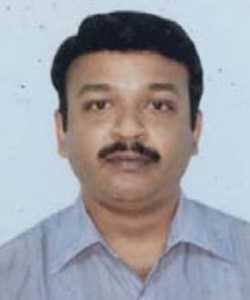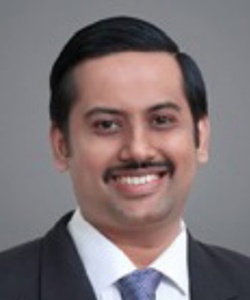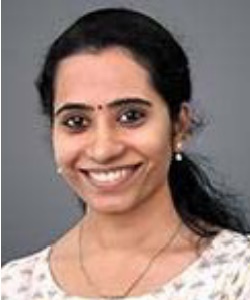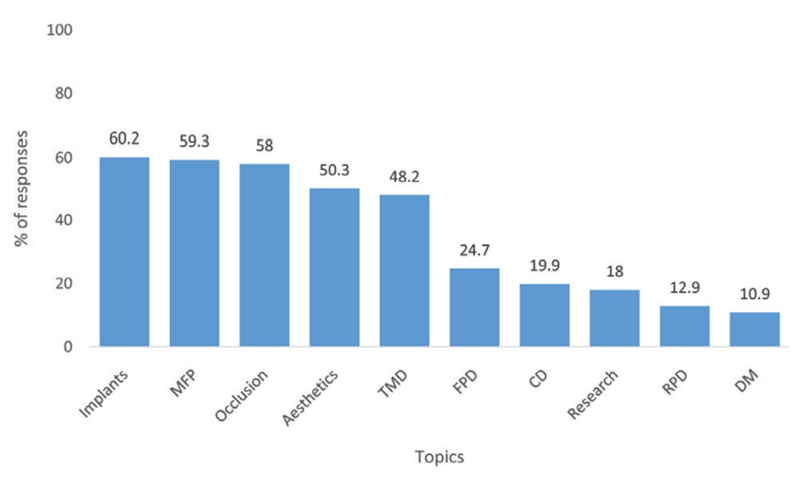


1. Dr Aswini Kumar K
Reader, Department of Prosthodontics,
Amrita School of Dentistry, Amrita
Vishwavidapeetham,
Cochin.

2. Dr Venkitachalam Ramanarayanan
Assistant Professor,
Department of Public Health Dentistry,
Amrita School of Dentistry, Amrita
Vishwavidapeetham, Cochin.

3. Dr Saranya S K
Assistant Professor, Department of
Prosthodontics,
Amrita School of Dentistry, Amrita
Vishwavidapeetham, Cochin.
The current trends in Prosthodontics
The scientific awakening of the branch of Prosthodontics
in India happened two years after independence, when
the premier dental college started by Dr. Rafiuddin Ahmed
got affiliated to the University of Calcutta and was raised
to the status of university education in 1949(1).
As dentistry were in its infancy and the practitioners were
primarily exodontists, the removable prosthodontics and
especially complete dentures gradually started gaining
popularity. Those were the days of bakelite, celluloid or
vulcanite dentures where porcelain teeth was bonded to the
denture base by means of diatoric holes. The challenge of
accommodating the porcelain teeth in the limited inter-arch space, were slowly answered by the introduction of
acrylic resin in the 1950s.
The removable partial dentures might have preceded
the complete denture fabrication in the evolution of
dentistry in India. Initially were the days of untrained
dental practitioners who used carved out tooth attached to
self-cure. But the appropriate effective use of the materials
through experience started yielding better results. The
acrylic partial dentures continue to remain popular among
the practicing dentists even to this day,especially to serve
the immediate prosthetic needs of the common man.
As these remain to be ignored by the major text books by
referring it as gum strippers or flippers, there is a lack
of instructions,as manual or text books could makes our
new graduates incompetent in design and fabrication of
acrylic partials1.
Crude materials like Plaster of Paris or bees wax were
being replaced by more user-friendly materials like zinc
oxide eugenol and as technology progressed, operator
comfort was enhanced with the introduction of hydrocolloid
and elastomeric impression materials1,2.
This was followed by the advent of cast partial dentures.
Though widely discussed in textbooks and during training
curriculum, it remains an unpopular choice among patients
due to its un-aesthetic appearance. Demands on clinical
and the lab time have also resulted in reduced popularity
among dentists. However, it is still a preferred option
for a category of patients demanding better comfort of removable and maxillofacial prosthesis. Furthermore,
the introduction of materials like Titanium, PEEK and its
modifications also enhanced patient comfort.
With a view to further enhance patient comfort, elimination
of visible retentive elements and problems of allergy to
acrylic resin, flexible polyamide dentures base materials
have been in vogue recently and have shown promising
clinical results. But these materials require additional
clinical research to establish its longevity.
While it was being acknowledged that removable
prosthesis was not the best in terms of patient comfort
and use, fixed prosthodontics gained popularity and till
date is the most widely used and preferred option for
replacement of lost tooth. Though fixed prosthodontics
have been attempted by traditional dentists, who wound
carved tooth to adjacent teeth with wires, proved to be
unhygienic and crude . A more scientific and technical
approach for the replacement of missing tooth with fixed
partial dentures started in the 1970s. The transition of
metal to metal-ceramic restorations in the 1990s was
a revolution in the field of fixed partial dentures when
aesthetics in addition to function was in demand. It has
now evolved into the use of metal-free ceramic restorations
and technology like CAD/CAM which have drastically
improved the esthetics and precision and at the same
time reduced laboratory time.
The advent of dental implants has been a game-changer
in the field of prosthodontics. The Introduction of newer
designs and surface treatments have improved the
success rate of implants3,4. While the average life span
of fixed partial denture is about 10 years, single implant
tooth has shown a success rate above 97% for the same
time period, this field has received enormous attention
of dentists and researchers alike4. With the increased
thrust given to implantology in the present post graduate
curriculum and the knowledge of stomatognathic system,
prosthodontists today play a major role in this domain.
The concomitant advances in imaging technologies like
CBCT have further fuelled its rise in the field of prosthetics.
It has been estimated that the use of implants will near
500K per annum5. With the common complications like surgical trauma, lack of primary stability, bone
necrosis, failure to osseointegrate, bacterial infection
and failures due to improper loading protocols being
countered by improvements in the macro and micro
designs and improved treatment protocol, the implant
became predictable option6–8. The predictability and
the conservation of adjacent tooth structure with the
preservation of the oral well-being has also increased
the popularity of the implants.
The stem cell research is another field in dentistry which
has the potential to transform the way the field moves.
These are cells with the potential self-renewal and potency
to give rise to one or sometimes many different cell types9.
The 1980s saw an increased awareness of the
stomatognathic system. The factors such as stress and
occlusion were read together with temporomandibular
disorders during these times. The introduction of T
scans and allied myographic facilities improved the
diagnostic potential and thereby improved the outcome
of the treatment10.
The Integration of dental implants with removable
prosthesis has opened up a new possibility in improving
the prognostication. This is of extreme help, when the
retention of removable prosthesis is difficult as in the case
of maxillofacial defects. The initial maxillofacial work
taken up by the prosthodontists were only the fabrication
of obturators. The 1980s saw the attempts for life like facial
prosthesis with acrylic. This was followed by the rapid
popularity of medical grade silicon into maxillofacial
prosthodontics 1990s, which could mimic the texture and
appearance of the skin and there by the improving the
patient acceptance and related quality of life. The branch
is in the process of metamorphosis with the opening of
many new centres for research and development.
The recent time saw the introduction of 3D CAD-CAM
technology, the colour matching of facial prosthetic
elastomers to skin colour with portable spectrophotometer
and computerized colour formulation. The attempts for
“Active Prosthesis” such as blinking and moving eye
and advancements in tissue engineering which could
revolutionise reconstruction of tissue defects11,12 are
promising additions to this field.
The digital technologies like rapid prototyping enables
to mimic the internal and external bony morphologies
and thereby creating a 3-D anatomic models of the
particular patient with all the complex shapes with internal
detail and undercut areas. These data may be digitally
manipulated to create contact-free reproduction of facial surface features, mirror anatomic parts, and produce
models in various scales to compensate for patient growth
or material distortions there by reducing the operating
time and improved treatment planning and outcome.13,14
Thus the practice of prosthodontics in India has undergone
a metamorphosis from the work of untrained professional
to an ultra-modern science incorporating the latest cutting
edge technologies. Today India is contributing substantially
towards the science of prosthodontics. As of now as India is
emerging as the hub for manufacturing and data services,
opening the door for the research activities and product
development.
In order to make our speciality knowledge and skill based,
newer and newer study methodologies are being adopted.
The recent years have seen the introduction of mentor
based small group education with thrust in research. These
have evoked a critical thinking ability among the students
rather than them just being knowledge consumers.11
Though dentistry is associated with high treatment costs,
the demand for better function, aesthetics and thereby an
improved quality of life has results in the rapidly changing
trends in the field of prosthodontics. The Indian sub-continent holds the second largest population in the world
and has its 7.7% of population above 60 years of age with
a total prevalence of edentulism reported to be 11.7%15.
The improved life expectancy notwithstanding the presence
of medically compromised conditions among geriatric
patients has placed a greater thrust in the speciality to
improvise dental care and minimize patient discomfort.
Thus the speciality has been evolving continuously by
incorporating the evidence based science into the clinical
scenario, there by enriching the quality of life of patient
by meeting the ultimate goal to attain function, aesthetics
and preservation of health.
Preferred subject areas among
postgraduates in the field of
Prosthodontics in India
An opinion poll was conducted among postgraduate
students of Prosthodontics in India to gain insights the
trends and preferences of post-graduate students among
the various focus areas of the speciality. A survey was
conducted as a part of National PG Convention held
at Kochi in March 2020. The budding prosthodontists
were asked to rate 10 specialty options in order of their
preference and also suggest any other field of interest
not listed in the given options. The topics listed in the
questionnaire were Complete denture prosthodontics, fixed partial denture prosthesis, removable partial
denture prosthesis, temporomandibular disorders and
its management, maxillofacial prosthodontics, occlusion,
implant prosthodontics, research, dental materials,
aesthetics in prosthodontics and ‘others’.
Among the 194 responses obtained from all over India, it
was observed that implantology, maxillofacial prosthesis
and temporomandibular disorders and occlusion were the
most preferred topics of interest while dental materials,
removable prosthodontics and research were among
the least preferred areas of interest. This observation is
consistent with the paradigm shift that has occurred in
the field of prosthodontics over the years.
However, the comparatively lesser preference towards
research is of concern as science is built on the pillars
of research. In the field of health sciences, it is scientific
research that guides the evolution of a specialty.
Discussion
There are many factors which formulate the development
of interest to a subject among the students. It can range
from the ease of mastering to the financial benefits. It
has been noted from previous international studies that
the preference of specialty is influenced by role models.
This may be parents or relatives in the same profession
to teachers. Students often choose clinical role models
who excel in their clinical skills, usually people who accept
and incorporate newer materials and techniques. As our
top preferences are from the newer and evolving fields
in prosthodontics, the role of mentors need to be read
together(16–18).

Table: Top three preferred topics in Prosthodontics among postgraduate students
Several factors influence changing trends in a specialty.
Patient demands, technological advances and economics
are a few among them. Though dentistry is associated
with high treatment costs, the demand for better function,
esthetics and thereby an improvement in quality of life
has resulted in the rapidly changing trends in the field of
prosthodontics. The case in point is that of maxillofacial
prosthesis which has drastically changed the lives of
people.
The reduced cost and high quality of work output and the
induction of cutting edge technologies into practice has
paved way for India to become a dental tourism hub(19).
This increased the patient number calls for more number
of specialists as well as the financial benefits associated
with it.
With the general social and economic improvement, the
dental treatments are becoming more and more accessible
a larger population. These involves an increased number
of procedures for aesthetic and functional purpose.
Some of these treatments with only aesthetic upliftment
in mind needs a thorough knowledge of stomatognathic
system. This along with other factors like increase in
social and professional stress has increased the number
of temporomandibular dysfunction patients(20). This
demands the role of prosthodontics with a interdisciplinary
approach.
The above specialties are also among the among
those which involves service to the society. Eventhough
maxillofacial prosthetics are not among the most financially
viable, the passion to the subject along with the social
service involved attracts many students.
In order to make our specialty knowledge and skill based,
newer and newer study methodologies are being adopted.
The recent years have seen the introduction of mentor
based small group education with thrust in research. These
have evoked a critical thinking ability among the students
rather than them just being knowledge consumers(16).
The development of interest in research needs to be
emphasized as science is built on the pillars of research.
In the field of health sciences, it is scientific research that
guides the evolution of a specialty.
Today India is contributing substantially towards the
science of prosthodontics. As of now as India is emerging as
the hub for manufacturing and data services, opening the
door for the research activities and product development.
This requires the channelization of more and more of young
professionals to research and development.